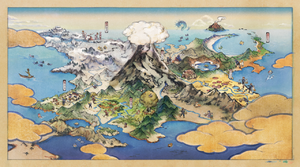Hisui: Difference between revisions
No edit summary |
mNo edit summary |
||
| Line 97: | Line 97: | ||
* [[Pokémon Legends: Arceus]] | * [[Pokémon Legends: Arceus]] | ||
* [[Regional form]] | * [[Regional form]] | ||
==References== | |||
<references> | |||
</references> | |||
{{-}} | {{-}} | ||
{{Regions|Hisui}} | {{Regions|Hisui}} | ||
Revision as of 22:23, 27 March 2022
- If you were looking for the character from The Power of Us known as Hisui in Japanese, see Harriet.
| |||||||||||||||||||
| |||||||||||||||||||
| |||||||||||||||||||
| |||||||||||||||||||
| |||||||||||||||||||
| |||||||||||||||||||
The Hisui region (Japanese: ヒスイ地方 Hisui region) refers to Sinnoh as it was known during discovery and settlement, in a historical period set prior to Generation IV. It is the setting of Pokémon Legends: Arceus.
Etymology and design concept
Etymology
Hisui could be transliterated to kanji in a number of ways, such as 祕邃 hisui (arcane), the latter of which is close to Sinnoh's name origin. An official transliteration to kanji has not yet been revealed. Conventionally, ヒスイ would be seen as the alternative spelling of 翡翠 hisui (jade).[1]
Design concept
- Main article: Pokémon world in relation to the real world → Sinnoh
Hisui is likely based on the Japanese island of Hokkaido while it was still known as Ezo, referring to its inhabitants prior to the Meiji Restoration. In 1869, the northern frontier was renamed to its current administrative title, which translates to northern sea circuit.
History
- Main article: Sinnoh → History
According to Cogita, the earliest human inhabitants of Hisui lived one or two millennia before the events of Pokémon Legends: Arceus. This society worshiped Arceus and built the ancient ruins that can be found across Hisui and modern-day Sinnoh, such as the Solaceon Ruins and Snowpoint Temple. A legend states that around this time, an ancient hero befriended the island's ten special Pokémon, who had received Arceus's blessing, and gathered the Plates in order to find Arceus.
The next humans to arrive in Hisui came from across the sea. The Diamond Clan and Pearl Clan both worshiped a deity known as "almighty Sinnoh", with the Diamond Clan claiming it created time and the Pearl Clan claiming it created space. This disagreement set off a long-running feud between the two clans. Members of the clans also came to venerate the descendants of the blessed Pokémon, and some of them were tasked as wardens to tend to the needs of the blessed Pokémon.
The latest arrivals in Hisui were the Galaxy Expedition Team, comprised of people from numerous other regions including Hoenn, Alola, and Galar. The Galaxy Expedition Team had been assembled to evaluate Hisui's viability for settlers, and to that end, it embarked on an ecological study of the region. A significant part of this study involved the creation of the first complete Hisuian Pokédex at the direction of Professor Laventon. The expedition brought with it newly-invented technology that allowed its members to conveniently capture and store Pokémon: Poké Balls. Two years after the establishment of Jubilife Village, a space-time rift appeared above Mount Coronet, followed sometime later by the emergence of a strange visitor who assisted in the completion of the Pokédex.
Geography
Notable locations

Settlements
Landmarks
- Obsidian Fieldlands
- Crimson Mirelands
- Cobalt Coastlands
- Mount Coronet (Coronet Highlands)
- Alabaster Icelands
Trivia
- The adjectival form of Hisui is "Hisuian", as seen in the term Hisuian.
- During the post-game of Pokémon Legends: Arceus, Kamado muses that Hisui could be called the Sinnoh region after the deities the Diamond and Pearl Clans worship, alluding to the region's present-day name.
- Aside from the Coronet Highlands, the names of the four main areas of Hisui correspond to the colors associated with the Chinese Four Symbols: the Black Tortoise of the North (Obsidian Fieldlands), the Vermilion Bird of the South (Crimson Mirelands), the Azure Dragon of the East (Cobalt Coastlands), and the White Tiger of the West (Alabaster Icelands). The locations for two of the main areas even correspond to the cardinal directions the Four Symbols represent: the Crimson Mirelands is located roughly in the south or southeast of Hisui, and the Cobalt Coastlands is located in the east of Hisui. The Forces of Nature will also start roaming each of the four areas on certain weather conditions, after the player receives the request "Incarnate Forces of Hisui".
In other languages
| Language | Name | Origin |
|---|---|---|
| German, Spanish, French, Italian |
Hisui | From its Japanese and English name |
| Korean | 히스이 Hiseui | Transcription of its Japanese name |
| Chinese (Mandarin) | 洗翠 Xǐcuì | Transcription of its Japanese name. Contains 翠 cuì (jade). |
| Chinese (Cantonese) | 洗翠 Sáicheui | Mandarin-based transcription of its Japanese name. Contains 翠 cheui (jade). |
| Russian | Гисуи Gisui | Transcription of its English name |
See also
References
| Regions in the Pokémon world | ||
|---|---|---|

|
This article is part of Project Locations, a Bulbapedia project that aims to write comprehensive articles on every location in the Pokémon world. |

